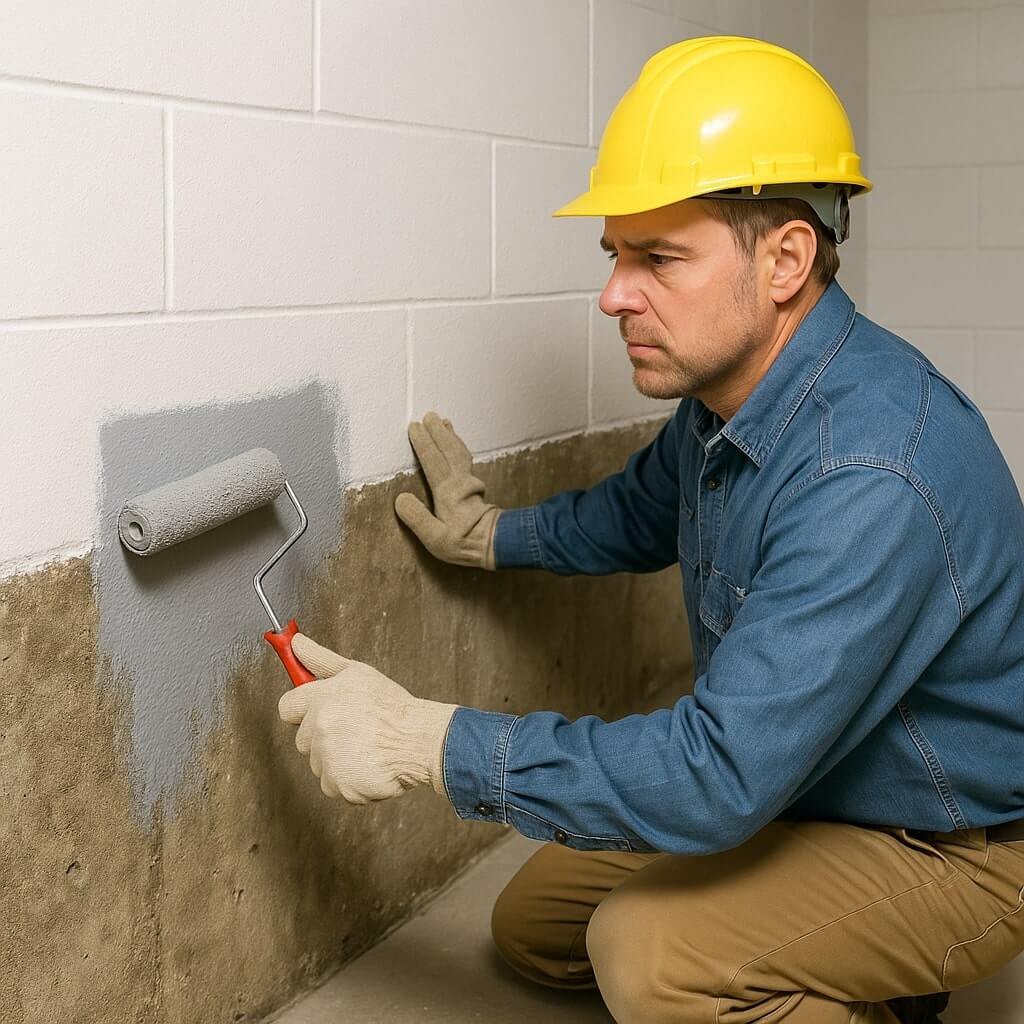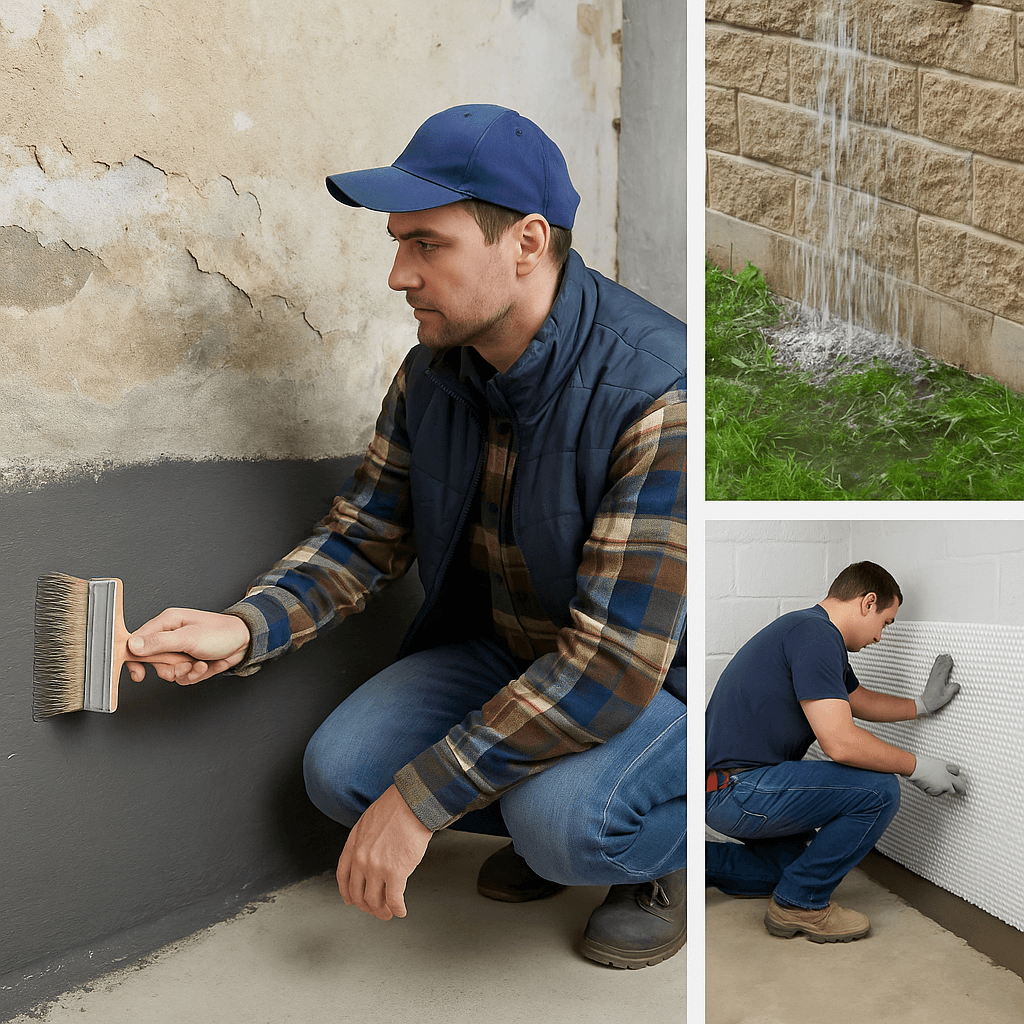If you’re looking to waterproof your finished basement, it’s crucial to start with a thorough assessment of any existing water issues. You’ll need to identify the common sources of water intrusion, which can lead to damage and mold growth. By understanding these factors, you can take practical steps to protect your space. Let’s explore how to effectively inspect your basement and the surrounding exterior to guarantee a secure, dry environment.
Key Takeaways
- Inspect the basement for signs of water damage, dampness, and mold to identify existing issues before waterproofing.
- Ensure proper drainage by checking gutters, downspouts, and grading to direct water away from the foundation.
- Seal any cracks and gaps in walls and floors using appropriate sealants to prevent moisture entry.
- Install a sump pump in the lowest part of the basement to manage excess water and prevent flooding.
- Maintain humidity levels and regularly inspect for leaks, ensuring prompt action to prevent mold growth.
Assessing Your Basement for Water Issues
How can you tell if your basement has water issues? Start by inspecting for signs of water damage, like stains or peeling paint on walls.
Inspect your basement for water damage signs, such as stains or peeling paint on walls, to identify potential issues early.
Feel for dampness or signs of mold, which indicate moisture detection problems. Check the floor for cracks where water might seep in.
Use a moisture meter to measure levels; anything above 15% suggests a concern. Don’t forget to look around windows and doors for leaks.
If you find any issues, act quickly to prevent further damage. Addressing these problems early can save you time, money, and hassle in the long run.
Understanding Common Sources of Water Intrusion

While you might think your finished basement is safe from water intrusion, it’s important to understand the common sources that can lead to unexpected issues.
Identifying these water sources is vital for effective moisture management. Here are five common culprits:
- Poor drainage systems
- Cracked foundations
- Leaky pipes
- Groundwater seepage
- Improperly sealed windows and doors
Inspecting the Exterior of Your Home
Before you start waterproofing your finished basement, take a close look at the exterior of your home, as many water intrusion problems originate outside.
Begin with a thorough foundation inspection; check for cracks or signs of deterioration that could allow water entry.
Next, examine the grading around your home. Verify the ground slopes away from the foundation to prevent drainage problems.
Inspect your gutters and downspouts, making sure they’re clear and directing water far from the foundation.
Addressing these external issues first can greatly reduce water intrusion and protect your finished basement from potential damage.
Sealing Cracks and Gaps in Walls and Floors
To effectively waterproof your basement, start by identifying any cracks and gaps in the walls and floors where moisture could seep in.
Once you’ve pinpointed these problem areas, choose the right type of sealant that suits the size and severity of the gaps.
This targeted approach will help guarantee a more effective barrier against water intrusion.
Identify Problem Areas
Identifying problem areas in your basement is essential for effective waterproofing, as even the smallest cracks and gaps can lead to significant water intrusion.
Start with a thorough foundation assessment and moisture detection to pinpoint vulnerabilities.
Look for:
- Cracks in walls and floors
- Gaps around windows and doors
- Signs of mold or mildew
- Water stains on walls
- Dampness in corners or near drains
Once you’ve identified these issues, you’ll be better equipped to tackle them.
Addressing these cracks and gaps now will save you time and money in the long run, ensuring a dry, safe basement.
Choose Sealant Type
Choosing the right sealant is crucial for effectively sealing cracks and gaps in your basement walls and floors.
For permanent solutions, consider using epoxy sealants, which bond tightly and are highly durable. They’re perfect for larger cracks and provide a robust barrier against moisture.
On the other hand, silicone sealants are ideal for smaller gaps and areas that might experience movement. They’re flexible and waterproof, making them great for joints and seams.
Before applying, clean the surfaces thoroughly and follow the manufacturer’s instructions for the best results. This guarantees a watertight seal, keeping your basement dry and protected.
Installing a Sump Pump for Effective Drainage

When you want to guarantee effective drainage in your finished basement, installing a sump pump becomes an essential step.
Here are some important installation tips to take into account:
Consider these essential installation tips for your sump pump to ensure effective drainage in your basement.
- Choose the right sump pump type: Select between submersible or pedestal pumps based on your needs.
- Locate the sump pit: Verify it’s in the lowest part of your basement.
- Install a discharge pipe: Direct water away from your foundation.
- Use gravel for drainage: Place gravel around the sump pit for ideal water flow.
- Connect a backup system: Think about adding a battery backup for peace of mind during power outages.
These steps will help maintain a dry basement.
Applying Waterproof Coatings and Sealants
To effectively protect your finished basement from moisture, applying waterproof coatings and sealants is essential. Start by cleaning the walls and floors thoroughly. Choose high-quality waterproof coatings, ensuring they’re suitable for your basement’s surface. Once dry, apply the sealant using a roller or brush, ensuring even coverage. Pay special attention to corners and seams for a complete sealant application.
| Step | Action | Emotion Evoked |
|---|---|---|
| 1 | Clean surfaces | Relief |
| 2 | Choose coatings | Confidence |
| 3 | Apply sealant | Empowerment |
| 4 | Inspect your work | Satisfaction |
Ensuring Proper Drainage and Grading
To protect your finished basement, start by ensuring proper drainage and grading around your home.
You’ll want to assess the slope of your yard to direct water away from your foundation, and consider installing a drainage system if necessary.
Site Grading Techniques
Effective site grading is essential for guaranteeing proper drainage around your finished basement.
To achieve ideal site elevation and landscape grading, consider these techniques:
- Assess the slope: Guarantee the ground slopes away from your foundation.
- Create swales: Design shallow ditches to direct water flow.
- Use soil compaction: Compact soil to prevent settling over time.
- Install drainage ditches: Channel excess water away from your property.
- Maintain vegetation: Plant grass or shrubs to absorb water and reduce runoff.
Drainage System Options
While you may have taken steps to grade your site effectively, a well-designed drainage system is essential for ensuring water doesn’t accumulate around your finished basement. Consider these drainage system types for effective drainage solutions:
| Drainage System Type | Description |
|---|---|
| French Drain | A trench filled with gravel that directs water away from the foundation. |
| Sump Pump | Pumps out water that collects in a sump basin, preventing flooding. |
| Gutter and Downspout | Directs roof water away from the foundation, reducing moisture around your basement. |
Choose the right system based on your specific needs to keep your basement dry and safe.
Maintaining a Humidity Control System
Maintaining a humidity control system is essential for preserving the integrity of your finished basement, especially since high humidity can lead to mold growth and structural damage.
A humidity control system is crucial for your finished basement to prevent mold and structural damage.
To effectively manage moisture, follow these steps:
- Regularly check and replace air filters.
- Clean dehumidifiers and verify they’re functioning properly.
- Monitor humidity levels with a hygrometer.
- Seal any cracks or gaps that may allow moisture in.
- Confirm proper ventilation, especially in corners and tight spaces.
Regularly Inspecting and Maintaining Your Waterproofing Solutions
Regular inspections of your waterproofing solutions are essential for ensuring your finished basement remains dry and damage-free.
Create a maintenance schedule to check for any signs of wear or damage, such as cracks in walls or issues with seals. Inspect sump pumps, ensuring they’re functioning properly, and clean gutters to prevent overflow.
Look for any moisture build-up or mold, as these can indicate underlying issues. Don’t forget to examine window wells and exterior drainage systems.
Conclusion
By taking these proactive steps, you can effectively waterproof your finished basement and create a safe, dry space. Regularly inspect your waterproofing solutions and maintain proper drainage to prevent future issues. Don’t forget to monitor humidity levels and address any signs of moisture promptly. With consistent care and attention, your basement can remain a comfortable area in your home for years to come, free from the threat of water damage and mold growth.




